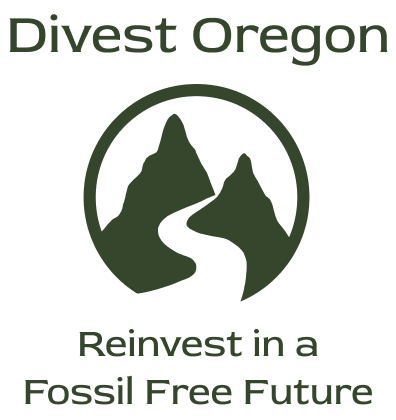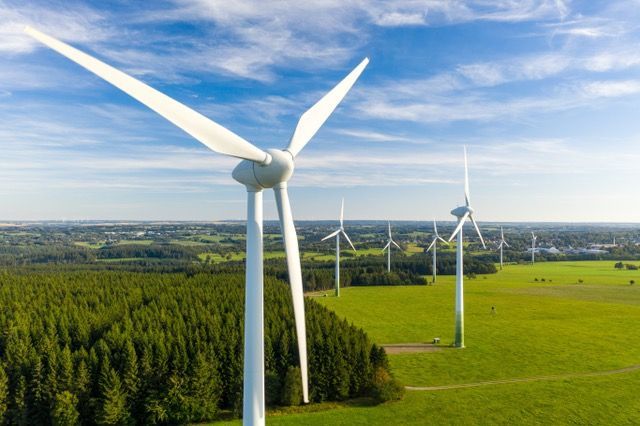Oregon Treasury's Net-Zero Plan
What's a Net-Zero Plan?
A net-zero plan is one that seeks to arrive at a balance between the amount of greenhouse gas that is produced by investments and the amount that investments remove from the atmosphere.
What Treasury fund does the Net-Zero Plan apply to?
The Oregon Treasury's Net-Zero Plan only applies to the $93 billion Oregon Public Employee Retirement Fund's - not the $40 billion that are also managed by the Treasury.
What is the Goal for the Oregon Net-Zero Plan?
The stated goal in the plan is to: “Achieve net zero portfolio emissions no later than 2050, with an interim goal of a 60% reduction in portfolio emissions intensity by 2035, relative to a 2022 baseline.”
What's in the Oregon Net-Zero Plan?
-
What emissions are covered in the Net-Zero Plan?
The Oregon Net-Zero Plan includes emissions from company operations, such as from product production activities (“Scope 1”), and emissions from the company’s purchase of electricity or other energy (“Scope 2”). The plan does not include emissions a company affects through the usage of its product (“Scope 3”).
The Oregon Net-Zero plan is using emissions intensity instead of absolute emissions. Emissions intensity equals total emissions divided by total dollar investment amount.
-
What is Treasury's rationale for the 2035 interim 60% reduction goal?
Treasury states that a 60% reduction in portfolio emission intensity can be met by 2035 and net-zero by 2050. The plan states that anything sooner would cause major disruption to OPERF investment returns.
-
How will Treasury meet their net zero targets?
- Increase the percentage of investments in companies, indexes or funds that have a climate strategy aligned with the Net Zero Plan
- Increase “climate positive” investments (ie those that remove CO2) and investments that promote “climate solutions” such as renewable power infrastructure
- Consider exclusions and re-allocations to manage exposure to potentially stranded assets (ie those that lose value with climate change, such as coal)
- Evolve portfolio composition to lower intensity sectors such as technology and health care away from high carbon intensity sectors such as utilities and energy
-
What are the 4 actions Treasury will take next?
1. By February 2025, Treasury will conduct a review of publicly traded carbon intensive fossil fuel investments to ensure they meet minimum standards for clean energy transition. These include thermal coal, tar sands, and fracked oil and gas.
2. By 2035, Treasury will increase "Climate Positive" investments as follows:
- Publicly traded: 10% of active (ie managed) and 30% of passively held (ie indexed)
- Private investments: triple climate positive investments from $2 billion to $6 billion.
3. By 2035, Treasury will ensure that 65% of emissions from private investments and 90% of emissions from real estate holdings are from companies with credible net zero transition plans.
4. Treasury will exclude new investments in private market funds that have the stated intention to invest primarily in fossil fuels.
KEY SIGNIFICANCE
The Oregon Net-Zero Plan acknowledges that climate change risk is a financial risk to the Oregon Public Employee Retirement Fund (OPERF) that threatens the benefits for retired state employees and commits to mitigating that risk.
Following are other reasons that this plan is significant:
Why is the Oregon Net Zero Plan significant?
Brings Treasury in line with other State agencies
Other Oregon agencies were mandated by
executive order in 2020 “to take actions to reduce and regulate greenhouse gas emissions” (Governor’s Executive order 20-04).
Commits to reducing the “greenhouse gas footprint”
The Treasury will measurably reduce fossil fuel emissions of the Oregon Public Employee Retirement Fund (OPERF) and begin by partially quantifying that footprint with industry standard methodology.
Includes private investment funds' emissions
Most other state pension plans do not include the emissions from private investments that their pension fund investments are causing.
Takes immediate steps to address financial climate risk
Focuses first on thermal coal, oil sands and fracked shale oil and gas by February 2025.
Commits to no new investments in private funds that are “primarily” fossil fuel focused.
The Oregon Net-Zero Plan
Raises Significant Questions
Will the Net Zero Plan actions occur
soon enough to protect OPERF beneficiaries from climate risk?
To mitigate the financial risks of climate change, Treasury must act before the market devalues assets that are no longer wanted due to their negative climate impact. The value of investments in fossil fuels can be diminished by flooding, hurricanes, or fire caused by climate change.
Bottom line: Although the Net Zero Plan states that its 2035 60% emissions reduction and 2050 Net Zero targets are as aggressive as Treasury can be without major portfolio disruption, scientific evidence suggests major portfolio disruptions from climate change will occur sooner. The Net Zero Plan timelines should be accelerated in line with updated science to protect OPERF beneficiaries. Read more...
Is the Net Zero Plan’s measurement of investment emissions comprehensive enough to identify all of OPERF’s significant climate financial risk?
The Net Zero Plan acknowledges that analyzing the exposure of a portfolio of OPERF’s size and complexity to direct and indirect greenhouse gas emissions is essential to assess our exposure to physical and transition risks.
But the current Net Zero Plan has a significant loophole: It excludes measurement of “indirect” Scope 3 emissions, which are estimated to be 75% of a company’s emissions. For example for an oil company like Exxon, the Net Zero Plan analysis includes the company’s emissions from drilling, transporting and refining oil (Scope 1) and emissions from the power the company purchases (Scope 2), but not the majority of emissions from burning the oil or gas the company produced (Scope 3). And companies like Exxon are reporting Scope 3, yet the Net Zero Plan does not include it.
In addition, physical damage to assets due to flooding, hurricanes, or fire caused by climate change is not included in the Net Zero Plan.
Bottom Line: Omitting Scope 3 emissions and physical damage to OPERF assets due to climate change profoundly understates the risk to OPERF. Read more...

Will
engagement with fund managers
and companies to ensure OPERF investments have “credible net zero transition plans” be effective?
There is increasing evidence that engagement with fossil fuel companies does not work. The Net Zero Plan leaves key engagement criteria undefined.
Bottom Line: Given the current lack of evidence on the effectiveness of an engagement strategy, it will be up to the Treasury to demonstrate that it can satisfy its fiduciary duty to protect PERS beneficiaries by succeeding where others have consistently failed. Read more...
How will PERS beneficiaries and the public know this plan is working to protect pensions with the urgency called for by accelerating climate change?
Transparency is critical. As written, the Net Zero Plan lacks an annual robust reporting framework that would allow stakeholders to follow its implementation and ongoing results. The Plan needs to include interim targets so it can be adjusted as needed. Waiting until 2035 to know if it is “on target” is reckless. Read more...

How will the Net Zero Plan become a
formal policy
for the Oregon Investment Council (OIC)?
The Oregon Investment Council (OIC) is a 5-member board that oversees and sets policy for the Oregon Treasury. A plan to systematically mitigate climate risk is by definition a policy. The Net Zero Plan should be formalized, with the OIC ensuring that the Net Zero Plan is enacted urgently to proactively protect beneficiaries.


